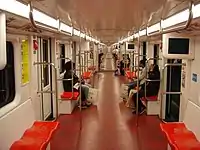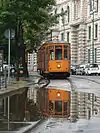Milan Metro
The Milan Metro (Italian: Metropolitana di Milano) is the rapid transit system serving Milan, Italy, operated by Azienda Trasporti Milanesi. The network consists of 4 lines, identified by different numbers and colours, with a total network length of 96.8 kilometres (60.1 mi), and a total of 106 stations, mostly underground.[1] It has a daily ridership of about 1.4 million on weekdays.[2]
 | |||
 Line M1 at Villa San Giovanni | |||
| Overview | |||
|---|---|---|---|
| Native name | Metropolitana di Milano | ||
| Locale | Milan, Lombardy, Italy | ||
| Transit type | Rapid transit | ||
| Number of lines | 4 (plus 1 under construction) [1] | ||
| Number of stations | 106[1] (113 with interchange stations counted multiple times) | ||
| Daily ridership | 1.39 million (2018 average weekday)[2] 1.57 million (2018 peak)[2] | ||
| Annual ridership | 369 million (2018)[3] | ||
| Website | ATM | ||
| Operation | |||
| Began operation | 1 November 1964[4][1] | ||
| Operator(s) | Azienda Trasporti Milanesi | ||
| Number of vehicles | 1,029 (2018)[3] | ||
| Technical | |||
| System length | 96.8 km (60.1 mi)[5] | ||
| Track gauge | 1,435 mm (4 ft 8 1⁄2 in) standard gauge | ||
| Electrification | Fourth rail (Line 1) Third rail (Line 5) overhead line (Line 2 and Line 3) | ||
| |||
The first line, Line 1, opened in 1964;[4] Line 2 opened 5 years later in 1969,[4] Line 3 in 1990,[4] and Line 5 in 2013.[6] A fifth line, Line 4, is currently under construction and will take service between 2021 and 2023.[7] The Milan Metro is currently the largest system in Italy for length, number of stations and ridership.
History

The first projects for a subway line in Milan were drawn up in 1914 and 1925, following the examples of underground transport networks in other European cities like London and Paris. Planning proceeded in 1938 for the construction of a system of 7 lines, but this too halted after the start of World War II and due to lack of funds.[8]
On 3 July 1952 the city administration voted for a project of a metro system[9] and on 6 October 1955 a new company, Metropolitana Milanese, was created to manage the construction of the new infrastructure.[8] The project was funded with ₤ 500 million from the municipality and the rest from a loan. The construction site of the first line was opened in viale Monte Rosa on 4 May 1957.[8] Stations on the new line were designed by Franco Albini and Franca Helg architecture studio, while Bob Noorda designed the signage.[8] For this project both Albini-Helg and Noorda won the Compasso D'Oro prize.
The first section from Lotto to Sesto Marelli (21 stations) was opened on 1 November 1964, after 7 years of construction works. Two trains adorned with Italian flags left at 10.41 a.m. and arrived at the Sesto Marelli terminus at 11.15 a.m., greeted by the notes of the national anthem and the triumphal march of Giuseppe Verdi's opera "Aida". The track was 12.5 km (7.8 mi) long, and the mean distance between the stations was 590 m (1,940 ft).[10] In the same year, in April, works on the second line started. Passengers on the network grew constantly through the first years of service, passing from 37,092,315 in 1965 to 61,937,192 in 1969.[10]
The green line from Caiazzo to Cascina Gobba (7 stations) opened five years later. During the 1960s and 1970s the network of 2 lines was completed, and both lines had 2 different spurs. In 1978, the lines were already 17.6 km (10.9 mi) and 23 km (14 mi) long respectively, with 28 and 22 stations.[10]
The first section of the third line (yellow), with 5 stations, was opened on 3 May 1990 after almost 9 years of construction works. The line opened just before the World Cup. The other 9 stations on Line 3 opened to the southeast in 1991, and northwest to Maciachini Station in 2004.
In March 2005 the Line 2 Abbiategrasso station (south branch from Famagosta) and the Line 1 Rho Fiera station opened. The intermediate station of Pero opened on December 2005. A north extension of Line 3 to Comasina (4 stations) and a new south branch on the Line 2 to Assago (2 stations) opened in early 2011.

The first stage of the Line 5, covering the 4.1 kilometres (2.5 mi) from Bignami to Zara opened on 10 February 2013.[11] The 1.9-kilometre (1.2 mi) second stage, from Zara to Garibaldi FS, opened on 1 March 2014.[12] The 7-kilometre (4.3 mi) third stage, from Garibaldi FS to San Siro Stadio opened on 29 April 2015, with some intermediate stations not in service at that time;[13][14] as of November 2015, all the stations have been opened.
The metro replaced several interurban tramroutes of the original Società Trazione Elettrica Lombarda (STEL) tramlines. In particular the Line 2 to Gessate. The only remaining suburban tram line to Limbiate is shortened to Comasina, the endpoint of Line 3.
Timeline
Infrastructure
Lines
| Line | Terminals | Opened[4][6] | Latest extension |
Length (km) |
Stations | Avg. station distance (km) | |
|---|---|---|---|---|---|---|---|
| Rho Fiera / Bisceglie | Sesto 1º Maggio | 1964 | 2005 | 26.9 | 38 | 0.727 | |
| Assago Milanofiori Forum / Abbiategrasso | Cologno Nord / Gessate | 1969 | 2011 | 39.4 | 35 | 1.159 | |
| Comasina | San Donato | 1990 | 2011 | 16.7 | 21 | 0.835 | |
| San Siro Stadio | Bignami | 2013 | 2015 | 12.9 | 19 | 0.763 | |
Network Map

Details
All the lines run underground except for the northern part of Line 2 and the Line 2 Assago branch.
There are 7 interchange stations, each with 2 lines: Centrale (Lines 2 and 3), also Milan's main train station; Duomo (Lines 1 and 3), considered the center of the city; Loreto (Lines 1 and 2); Cadorna (Lines 1 and 2), city terminus for northbound suburban and regional railways; Zara (Lines 3 and 5); Garibaldi (Lines 2 and 5), also a major railway station; Lotto (Lines 1 and 5).
Lines run in the Milan municipality for the 80% of the total length (93 stations).[15] However, 12 other municipalities are served: Assago, Bussero, Cassina de' Pecchi, Cernusco sul Naviglio, Cologno Monzese, Gessate, Gorgonzola, Pero, Rho, San Donato Milanese, Sesto San Giovanni, Vimodrone. The network covers about 20% of Milan's total area.[15]
The metro network is also linked with the suburban rail service, with 12 interchange stations: Affori FN, Cadorna FN, Domodossola, Garibaldi FS, Lambrate FS, Lodi T.I.B.B. (with the nearby Porta Romana station), Porta Venezia, Repubblica, Rho Fiera, Rogoredo FS, Romolo, Sesto 1º Maggio,[16]
The track gauge for all lines is the 1,435 mm (4 ft 8 1⁄2 in) standard gauge. Most of the network has no platform screen doors, except for the newest Line 5, where screen doors are present in all stations and some stations on Line 1.
Power supply

Lines 2 and 3 use overhead lines to supply the electric current to the train and are electrified at 1500 V DC. Line 1, electrified at 750 V DC, uses a fourth rail system, although the same line also supports overhead lines in some stretches and depots; this allows Line 2 and 3 trains to use Line 1 tracks to reach a depot placed on the line. Line 5 trains are supplied by a third rail system at 750 V DC, and the same system will be used on the future line 4.
Signalling
Passenger information


Most of stations are provided with LED screens showing the destination and waiting time of coming trains. In every station, a recorded voice announces the direction of every approaching train and, at the platform, the name of the station. While older trains have no on-train information, the new Meneghino and Leonardo trains and the driverless trains on Line 5 are equipped with displays and recorded announcements in Italian and in English.
Rolling stock


The first 3 lines are heavy rapid-transit lines, with 6-cars trains, about 105 m in length. Line 5 is a light metro line, with 4-cars trains, about 50 m long.[18] Line 5 is equipped with driverless trains.
Service

Tickets

A standard ticket costs €2 and is valid for 90 minutes since its validation on metro, tram, bus, trolleybus and suburban lines within Milan and 21 bordering municipalities.[19] Other tickets are available as well, such as daily, weekly, monthly, annual, student and senior passes. Additional fares are required to travel outside Milan and the 21 bordering municipalities.[20]
Paper tickets can be substituted by contactless bank cards payments, provided the trip starts in the metro, by tapping in the orange gates installed in every metro station.[21] This payment method is not available on suburban lines; it was expected to be implemented on trams and buses starting by the end of 2019;[22] it was eventually introduced in December 2020 on three urban bus lines, with plans for coverage on all the network by 2023.[23]
Between 2004 and 2007 ATM introduced Itinero smartcard, a proximity card which can be charged with season tickets, replacing paper for this type of tickets. At the beginning of 2010, a new smartcard, RicaricaMi, was introduced. The new card can be charged up with credit and can be used for travel[24] in place of magnetic paper tickets, on the model of London's Oyster card.[25]
Milan metro lines can be accessed also with the regional integrated ticket "Io viaggio ovunque in Lombardia", as 1 to 7 days tickets or longer subscriptions using the smartcard "Io Viaggio".
Opening hours
The service starts at about 5:40 am and ends at about 0:30. During Sundays and holidays service usually starts later and ends later, depending on the occasion.[26]
Headways at peak hours vary from 2 minutes on the Line 1 (central part) to 3 minutes on Line 3. On branch lines (of lines 1 and 2) the headway is usually double.[26]
Night service
A night service has operated since 2015 with buses. The bus service follows the same route and stops at the same stations of the metro. The entire lines 1 and 3 and the urban section of line 2 (Abbiategrasso-Cascina Gobba) are covered by the service.
The future network
The metro system is currently expanding. An extension of Line 1 from Sesto 1º Maggio to Monza Bettola, towards the city of Monza, is currently under construction. The track will be 2 kilometres (1.2 mi) long with an intermediate station at Sesto Restellone. The completion has been delayed several times, and is now scheduled for 2021. There is a proposal for a further 3 km extension of Line 1 to the west.
An extension of Line 2 from Cologno Nord to Vimercate is planned. The section will be 10.8 kilometres (6.7 mi) long with 6 stations (Brugherio, Carugate, Agrate Colleoni, Concorezzo, Vimercate Torri Bianche, Vimercate). The track will be mostly underground (83%).[27]
Line 3 is planned to be extended to the south-east from San Donato to Paullo: 14.8 kilometres (9.2 mi) with intermediate stations in the city of San Donato, Peschiera Borromeo, Mediglia, Caleppio Cerca, Paullo and Paullo East, the first 3 being underground and the other on the surface.[27] The project is currently on hold.
.svg.png.webp)
| Line | Route or station[28] | Phase[28] | Scheduled opening[28] | Length | New stations |
|---|---|---|---|---|---|
| Sesto 1° Maggio–Monza Bettola | Under construction | 2021 | 1.9 km | 2 | |
| Bisceglie–Baggio | Approved (expected start of works: 2019) | 2022 | 3 km | 3 | |
| Cologno Nord–Vimercate | Design | – | 9.7 km | 5 | |
| Gessate–Trezzo sull'Adda | Design | – | 8 km | 4 | |
| San Donato–Paullo Est | Design | – | 14.8 km | 6 | |
| Linate Airport–Forlanini FS | Under construction | 31 January 2021[29] | 3,9 km | 3 | |
| Forlanini FS–Dateo | Under construction | 30 June 2022[29] | 1,8 km | 3 | |
| Dateo–San Babila | Under construction | December 2022[29] | 1,6 km | 2 | |
| San Babila–San Cristoforo FS | Under construction | 31 July 2023[29] | 7,7 km | 13 | |
| Bignami–Monza | Approved (expected start of works: 2021) | 2027 | 13.2 km | 12 | |
| San Siro Stadio–Settimo Milanese | Design | – | 4.5 km | 4 |

The new Line 4 will run from the western suburb of Lorenteggio to the eastern side of the city to Linate Airport, and is expected to open in 2022.[30] The line has been approved by the Italian Government in March 2006, and funded in November 2009. Preliminary prospections began in mid-2010, and construction started in late 2011. The construction of the whole line was approved by the city of Milan in November 2014.[31] Line 4 trains will be completely automatic and driverless, employing AnsaldoBreda Driverless Metro trains as in Line 5.
Line 4, which will run parallel to Line 5, will feature interchange stations with other M lines at Sant'Ambrogio (Line 2),[32] Sforza/Policlinico (with an underground link to Line 3 through Missori or Crocetta),[33] San Babila (Line 1),[34] and with suburban lines at San Cristoforo FS,[35] Dateo[36] and Forlanini FS.[37]
See also
References
- "L'opera che ha fatto di Milano una grande metropoli" [The work that has made a great metropolis of Milan] (in Italian). Metropolitane Milanesi SpA. Retrieved 20 June 2015.
- https://medium.com/lineadiretta/atm-record-di-passeggeri-e-centomila-multe-in-pi%C3%B9-b3e218743f3d
- "Bilancio Consolidato del Gruppo ATM e Bilancio di Esercizio di ATM S.p.A. 2018" (PDF) (in Italian). Azienda Trasporti Milanesi (ATM) SpA. April 2019. p. III. Retrieved 24 August 2019.
- "ATM's History". ATM. Retrieved 9 November 2013.
- https://www.atm.it/it/IlGruppo/ChiSiamo/Pagine/Numeri.aspx
- "La storia" [The history] (in Italian). ATM. Retrieved 9 November 2013.
- ANASTASIO, GIAMBATTISTA (26 May 2019). "Metro M4, tra un mese il primo treno alla stazione di Linate". Il Giorno (in Italian). Retrieved 9 February 2020.
- "La storia della linea 1". Metropolitana Milanese Spa. Retrieved 31 October 2011.
- Ogliari, Francesco (2006). Milano in tram : storia del trasporto pubblico milanese. Milano: Ulrico Hoepli. ISBN 978-88-203-3719-3.
- "La cronistoria della metropolitana di Milano". Cityrailways. Archived from the original on 20 March 2012. Retrieved 8 November 2011.
- "Milano Metro's first driverless line inaugurated". Railway Gazette International. 6 February 2013. Retrieved 6 June 2015.
- "Milano extends driverless Line M5". Railway Gazette International. 7 March 2014. Retrieved 6 June 2015.
- Sadler, Katie (1 May 2015). "Milan Metro Line 5 extension begins driverless operation". Eurotransport. Retrieved 6 June 2015.
- Chiandoni, Marco (1 May 2015). "Milan Line 5 extension opens". International Railway Journal. Retrieved 6 June 2015.
- "Metropolitane a Milano - L'opera che ha fatto di Milano una grande metropoli". Metropolitana Milanese. Retrieved 10 February 2012.
- see List of Milan Metro stations.
- "Telefonini in metrò: copertura al 100%". Azienda Trasporti Milanesi. Retrieved 26 February 2012.
- "Milan Line 5 The purple line connecting Garibaldi and Monza". Metropolitana Milanese S.p.A. Retrieved 7 August 2015.
- "Biglietto Atm a 2 euro: cosa cambia? Nuove tariffe, sconti, abbonamenti e zone di Milano". MilanoToday (in Italian). Retrieved 19 January 2020.
- "Biglietto Atm: nuovi prezzi, sconti, zone, tariffe e abbonamenti per la metro. Guida completa". MilanoToday (in Italian). Retrieved 2 August 2019.
- "Viaggia con la carta bancaria contactless ATM, Azienda Trasporti Milanesi". www.atm.it. Retrieved 2 August 2019.
- ""Addio" ai biglietti Atm: anche su bus e tram si paga con la carta, ecco come funziona. Video". MilanoToday (in Italian). Retrieved 7 November 2019.
- Anastasio, Giambattista (7 December 2020). "Il biglietto si fa direttamente sull'autobus: basta avvicinare la carta alle obliteratrici". Il Giorno (in Italian). Retrieved 15 December 2020.
- "Where to Stay in Milan". Archived from the original on 2 April 2015. Retrieved 17 February 2015.
- "ANCHE MILANO HA LA SUA OYSTER CARD: ITINERO RICARICAMI". Partodamilano. Archived from the original on 25 April 2012. Retrieved 2 October 2011.
- "Orari e calendario ATM". Azienda Trasporti Milanesi. Retrieved 2 November 2011.
- "Prolungamento linee Metropolitane e Nodo Interscambio Fiera". Comune di Milano. Retrieved 2 October 2011.
- "Metropolitana Milanese". Metropolitana Milanese. Archived from the original on 26 October 2011. Retrieved 11 October 2018.
- "A GENNAIO 2021 LA PRIMA TRATTA, DEFINITE LE NUOVE OPERE FINO AL TERMINE LAVORI–Metro 4–La linea Blu di Milano". www.metro4milano.it. Retrieved 8 April 2019.
- http://www.metro4milano.it/progetto/tracciato/
- "La Giunta approva delibera per M4". Comune di Milano. Archived from the original on 17 April 2015. Retrieved 16 December 2014.
- http://www.metro4milano.it/cantieri/stazione-s-ambrogio/
- http://www.metro4milano.it/cantieri/stazione-sforza-policlinico/
- http://www.metro4milano.it/cantieri/stazione-san-babila/
- http://www.metro4milano.it/cantieri/stazione-san-cristoforo/
- http://www.metro4milano.it/cantieri/stazione-dateo/
- http://www.metro4milano.it/cantieri/stazione-forlanini-fs/
External links
| Wikimedia Commons has media related to Milan metro. |
- ATM - Milan's Transportation Company
- Metropolitana Milanese S.p.A. - the company that built the Metro
- Milano Metro Map on Google earth with geolocation
.svg.png.webp)
